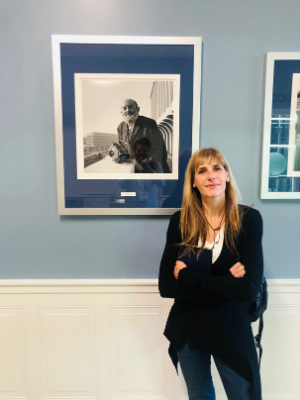 Bio
Bio
Interconnectedness is at the heart of Maria Whiteman’s art. Engaging with animals, landscapes, and most recently fungi, she uses multiple media including photography and video to convey the deep and intrinsic ties between humans and other living things. As these interrelationships underlie environmental science, her goal at the Environmental Resilience Institute (ERI) is to create a visual entry point for people to approach the science through a visceral, emotional experience.
For example, her ongoing “Mind, Body and Matter” series features a photograph of a man with turkey tail mushrooms appearing to grow from his back. This depiction of human skin as a medium for fungal growth underscores the reality of the many microorganisms that live on and in human bodies. In “Wildlife and Oil: In the Air,” images of a great white egret gliding among billowing smokestacks highlight the toxic emissions to which the bird is exposed – and, by, extension, the pollutants entering the lungs of nearby residents. This movement from compassion for animals to recognition of human vulnerability is also central to her work with taxidermy. Through video recorded in storage rooms of natural history museums, she uses the act of stroking the preserved bodies of polar and grizzly bears to capture the instinct to associate ourselves with these threatened species.
Moving to Indiana to join the ERI awakened Whiteman’s interest in fungi, as mushrooms are such a predominant feature of the local natural landscape. She is currently working with IU Professor Roger Hangarter (Plant Biologist) and PhD Katie Beidler (Mycelium and Decay Biologist) to grow and observe live fungi in addition to studying their role within ecosystems, environmental impact and their nutritional and medicinal uses. A forthcoming outdoor/indoor art installation series that Whiteman calls BioFungi Art is the next phase of her larger project at IU. It will consist of art that grows, decomposes and lives as part of a LiveArt installation. The upcoming art exhibits will invite residents to encounter these fungi through increasingly immersive media: first photography, then video, followed by virtual reality, and finally a living, growing installation allowing visitors to physically enter a fungal space. Eventually Whiteman would like to integrate BioFungi and LiveArt into Museums and Gallery spaces as contemporary eco-art. In the meantime, Whiteman is experimenting with fungal bricks as building material and mycelium filament as living mortal.
Transdisciplinary Subjects
Trends disappear and come back – this is not new. These days transdisciplinary, multidisciplinary and interdisciplinary are back, or maybe they never went away. Across the country, centers focused on the environmental humanities and environmental sustainability are drawing more attention and funding to sustain cross-disciplinary work on environmental change. I wonder if it is possible to take the notion of “collaboration” across the disciplines to see what sort of practice evolves from centers where the humanities and sciences work together. What would this look like? Can interdisciplinary programs become departments offering MAs and PhDs?
Why is it so important for the humanities to be part of this conversation? What do the humanities bring to our understanding of the Anthropocene, climate change and ecological crisis? Are the sciences strictly speaking about the Anthropocene topic or Anthropogenic landscape through the lens of ecology, geology and data? Or, do the sciences need the humanities to better extricate the fullness in connecting the links to a theorecticl hypothesis. In other words, taking the many parts in which, the sciences deliver data and information by using a different set of tools.
The natural sciences address the Anthropocene but in terms of ecological data that’s existed for billions of years (e.g., looking at biotic and abiotic research) and organisms that have survived the epochs –lichen, fungi, moss and carbon sequestering? At the Environmental Resilience Institute (ERI), discourse centers on words like impact, crisis, initiatives, changes, resilience and implementation. I sit in a room with scientists and social scientists explaining what they think of as “Trans-disciplinarily.” Which brings me to this talk but really open discussion on “Experimental Environments.” I will focus on Trans-disciplinary “Subjects” in two-parts: First, I will discuss “subject” as the subject of discussion, when subject becomes the object, and when subject is subjected to. In this point of my presentation, I will examine the differences between how science interprets the “transdisciplinary subject” and how the humanities frame it. Second, I will examine how I see myself as a subject who deeply engages scientific techniques for art production.
